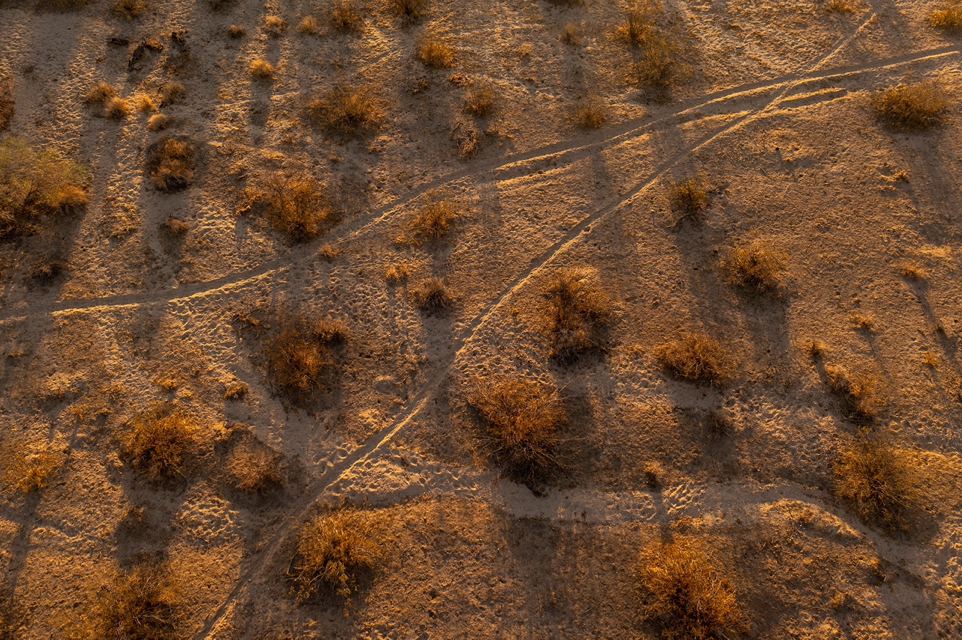A community near Scottsdale, Arizona, is running out of water. Amid the finger-pointing, the real question is: how many developments will be next?
The best gossip you’re likely to hear in Rio Verde Foothills, Arizona, is about water. Last month, when a few residents stopped by Karen Nabity’s sprawling, high-ceilinged home, the talk quickly turned to wells.
“My neighbor two lots to the east of me just got done putting in a nine-hundred-and-sixty-foot dry hole,” John Hornewer said.
Two women exchanged a horrified look. “How much did they put up, cost-wise?” Leigh Harris asked.
“I felt so bad I didn’t even ask,” Hornewer said. “I would venture to say it’s forty thousand dollars on a craps table that just crapped out.”
“Same thing with the lot across the street from me,” Cindy Goetz said. “Nine hundred feet, no water. And now the guy starts building.”
As the Southwest enters its second decade of megadrought, and the Colorado River sinks to alarmingly low levels, Rio Verde, a largely upscale community that real-estate agents bill as North Scottsdale, though it is a thirty-mile drive from Scottsdale proper, is finding itself on the front lines of the water wars. Some homeowners’ wells are drying up, while others who get water delivered have recently been told that their source will be cut off on January 1st. “It’s going to turn into the Hunger Games,” Harris said grimly. “Like, a scrambling-for-your-toilet-water-every-month kind of thing.” The fight over how best to address the issue is pitting neighbors against one another. “Water politics are bad politics,” Thomas Loquvam, the general counsel and vice-president of EPCOR, the largest private water utility in the Southwest, told me. “You know that saying, ‘Whiskey is for drinking, water is for fighting’? That’s very true in Arizona.”
The Southwest’s water issues are at a point of crisis. “What has been a slow-motion train wreck for twenty years is accelerating, and the moment of reckoning is near,” John Entsminger, the general manager of the Southern Nevada Water Authority, told Congress earlier this year. Arizona is one of seven states that, along with parts of Mexico, draw water from the Colorado River, which accounts for about a third of the state’s supply. (In the nineteen-seventies, Arizona built an extensive aqueduct system to channel river water to the central and southern regions of the state, in part to allay fears that it was overtaxing its finite supply of groundwater.) But the agreement divvying up the Colorado’s water was made at a time when flows were higher than they are now. In recent years, states that rely on that supply have had to contend with shortages, and experts predict that the situation is only going to get worse.
The Foothills is a twenty-square-mile community of some two thousand houses and horse farms in Rio Verde. It’s unincorporated, so homeowners don’t pay city taxes, or receive city services, including water. Many homeowners see this as a plus. When I asked the people at Nabity’s house why they opted to live where they do, several replied, enthusiastically and in unison, “No H.O.A.!” Nabity’s house is off an unpaved road, surrounded by acres of brushland, and the property is regularly visited by roadrunners and hawks and, on occasion, a great horned owl. “Sometimes I’ll have a whole row of little baby quails,” she said. “They look like little cottonballs.”
Recently, the downsides have become more visible. “It’s been keeping me up at night,” EPCOR’s Loquvam said. “Multiple nights, actually. I wonder if these people really understand what they were doing when they bought these homes.”
Most Foothills residents draw their water from wells, but several hundred homes sit on land without reliable access to water, so the inhabitants rely on cisterns, which they fill with a delivery from a water truck every month or so. When Cindy Goetz moved to Arizona from Illinois, in 2012, she had never heard of hauled water. “But I did some research on it—you know, is a well better, or is hauled water better? And my decision was, hauled water is better,” she told me. “A well can get contaminated, it can run dry. How about just pay a little extra to have someone bring it in from the city? It’s already drinkable. I asked [my real-estate agent] and he said that it’s done a lot in Arizona. And it wasn’t like a homestead out in the middle of nowhere. There were streets and power and phone lines and all that. I assumed it would be O.K. It wasn’t presented as, ‘By the way, it could stop.’ ”
THE DAILY
The best of The New Yorker, every day, in your in-box.
In 2018, Phoenix, concerned about its own supply, stopped selling water to haulers who serviced New River, an unincorporated community north of the city. Nabity grew worried that Scottsdale might make a similar decision and cut off supply to Rio Verde Foothills. If that happened, the water haulers could look for other sources, but trucking water in from farther away would cost significantly more. And what if other communities also stopped wanting to sell their scarce water to outsiders? Nabity, a real-estate agent, worried that water insecurity could prevent her from selling her home someday. But, when she and others began raising the issue, some of her neighbors accused her of fearmongering. Scottsdale promised to be a good neighbor, they insisted. The Foothills weren’t going to get cut off.
Then, last August, the Department of the Interior issued its first-ever formal water-shortage declaration for the Colorado River. A few months later, Scottsdale became the first city in Arizona to announce that it had entered Stage One of its drought-management plan. (Several other cities have since followed suit.) The city asked Scottsdale residents to decrease water consumption by five per cent. It also informed the water haulers that, starting in 2023, they could no longer buy Scottsdale water to deliver outside city limits—including to the Rio Verde Foothills.
Homeowners who didn’t have wells were suddenly uncertain that they’d be able to wash their dishes or flush their toilets. Some water haulers reassured their customers that they could find water for them, at least for now. Hornewer, who runs a water-hauling company, told me that not all haulers were scrupulous about the legality of their sources. “To them, it’s just kind of like the Old West,” he said. “If the water’s there, grab it. If you want to get it from Phoenix illegally, sure, you can do that. But that’s a short-term fix.”
Some residents came to believe that the best long-term solution for the hauled-water homes was to form a Domestic Water Improvement District, or DWID. The DWID, as a political subdivision, would be able to buy land to extract water from one of the few aquifers in Arizona that still had excess capacity for sale. A DWID could also get funding, or apply for grants, to eventually build water-treatment infrastructure for the area.
But not everyone in the Foothills wanted their neighbors to form a new government entity. Rumors spread on Facebook, claiming that the DWID was a power grab. People who had once acted as if worries about water scarcity were overblown began imagining their own elaborate worst-case scenarios: What if the DWID imposed taxes, or used the power of eminent domain to seize non-members’ wells, or put liens on people’s houses? What was next, an H.O.A.? “They have the power to condemn, whether they claim they’re going to use it or not,” Christy Jackman, the DWID’s most vocal opponent, told me. “They do have the power to put in streetlights, to pave areas. So here’s this little group, and they’ll have those powers.” The pro-DWID faction grew frustrated that their neighbors, many of whom had wells, were blocking their ability to secure water for themselves. “It’s the haves and the have-nots,” Nabity said. “Literally, some neighbors were like, ‘Screw you guys. You bought a property that doesn’t have water. That’s not my issue.’ ”
The DWID inspired petitions and counter-petitions. Long-standing friendships fractured. Karen Nabity got called, well, a Karen. On Facebook, people made catty comments about one another’s pools and fountains and lawn sprinklers and lush landscaping. They accused one another of lowering the water table and drying up neighboring wells. “I am so sorry for your well trouble but it has nothing to do with us,” one neighbor replied to an accusation. “The pool is to swim the horses.” Members of both pro- and anti-DWID factions reported being threatened. “People say things like, ‘You watch. In five years, you’re going to be begging me for water, and you ain’t getting it,’ ” Jackman said. Someone threatened to share Nabity’s address in an anti-DWID Facebook group. “I called my neighbors and we all sat on my patio, waiting, in case a mob came down to burn down my property,” Nabity said, tearing up at the memory. (No mob arrived.) Last September, the Maricopa County supervisor who’d been working with the DWID group resigned, after leaked recordings surfaced, in which he criticized fellow-Republicans for not supporting Arizona’s election audit.
Several months ago, a potential alternative to the DWID emerged. EPCOR, the private utility company, said that it would consider installing a standpipe in the Foothills, which the water haulers could use to serve local residents. Residents who didn’t like the idea of a utility formed by their neighbors found the idea of a private water provider more palatable. “I trust them,” Jackman told me. “I think they’re smart. This is what they do.”
But, for this plan to work, EPCOR would need to secure a water supply. “Where does new water come from in the Southwest? That’s the sixty-four-thousand-dollar question,” Loquvam said. “All the low-hanging fruit has been picked, water-wise. There is a second tier of water resources—it exists. But they are significantly more expensive than the existing water supply. Water prices that seem expensive right now will probably seem reasonable in ten years. There’s going to be a lot of outrage.”
EPCOR has been eying one of those second-tier options: groundwater from the Harquahala Valley basin, west of Phoenix. Arizona law mandates that, while a political subdivision such as a DWID can purchase groundwater from the basin, private companies such as EPCOR cannot. In recent years, though, the state has expanded private companies’ ability to buy water. In 2020, the Arizona Department of Water Resources endorsed a plan that would allow an investment company’s purchase of rural farmland in order to sell water access to developers in a Phoenix suburb. A bill currently before the state legislature would open up the Harquahala Valley groundwater to private investors, including EPCOR.
After all the discussions I’d had with Foothills residents about water scarcity, it was disconcerting to drive down the community’s mostly unpaved roads and see dozens of new houses under construction. Despite the ruptures within the community, the one thing that everyone seemed to agree on was that there was way too much development in the Rio Verde Foothills. Last year, Maricopa County added more residents than any other county in the country. “Well, yeah, it’s because they’re issuing building permits with no water,” Nabity said. “We are building way beyond our means.”
Later that afternoon, I went on a drive with Scott Riddle, who moved to the Foothills in 1999. Back then, the area was sparsely populated, and Riddle liked it that way. He dug a well and paid to make a road to his property. From his back porch, he had an uninterrupted view of the crags of the Superstition Mountains, fifty miles away.
In the nineties and early two-thousands, as Arizona’s population surged, real-estate investors began building spec homes in the Foothills. Development ramped up in the years before the 2008 financial crisis. After the market crash, construction subsided, only to return with a vengeance in the past five years. Many of the new homes will rely on hauled water—if it’s available. Arizona has long been aware of its finite water supply; a 1980 law requires developers to secure a hundred years’ worth of water for their projects. But the Foothills is plagued by what are known as wildcat builders. Because the hundred-year law applies only to subdivisions of more than five houses, wildcat builders often split parcels into five or fewer lots.
“All this used to be pretty much desert,” Riddle said, as we drove past a half-dozen slate-gray houses that now block his fifty-mile view. They sat on lots that were scraped down to bare dirt. Riddle told me that he complained to the county—“They can’t have six, they can only have five!”—but without success; the houses’ ownership was concealed in a tangle of L.L.C.s. “Not only are they building as dense as they can build, they’re scraping everything to the ground,” he said. “That’s creating heat islands, and erosion, and drainage problems—if we ever get any rain—because there’s no vegetation to hold it in. And the dust!” he said. The new construction upsets him so much that he doesn’t sit on his back porch anymore.
Many of the new houses in the Foothills were built by Morgan Taylor Homes, one of the biggest developers in Maricopa County. Instead of sprawling ranches, they are mostly two- and three-bedroom houses. Their prices, however, are not particularly modest: one eighteen-hundred-square-foot house near Riddle’s was listed at a little less than six hundred thousand dollars. “Who’s gonna spend five hundred ninety-five thousand dollars for a house with no water?” Riddle asked incredulously.
In between construction sites, Riddle turned his head to watch a coyote lope across the road. “Twenty years ago, I used to be able to drive from the top of this hill all the way to that turn and not see a single car. Now it’s just a constant stream of vehicles,” he said. “They say, ‘Oh, it’s market-driven.’ And I say, ‘Market-driven is fine! But you can’t just drive the place into the ground.’ ” He feared that, if the DWID secured a source of water, it would only encourage more people to move to the Foothills. “It’s people trying to make country life into city life,” he said.
As the January 1st deadline approaches, many Foothills residents still don’t know where their water will come from. The uncertainty and drama that keeps Nabity up at night doesn’t seem to be dissuading newcomers, though. “I just sold my daughter’s house, next door,” she said, shaking her head. “We got two great offers in, and neither of them cared about the water situation. They believe that the county is not going to let five hundred homes next to one of the wealthiest cities go without water.” ♦︎
NEW YORKER FAVORITES
When abortion is criminalized, women make desperate choices.
Of course the Constitution has nothing to say about abortion.
The study that debunks most anti-abortion arguments.
How the idea of Hell has reshaped the way we think.
A prized daughter of the Westboro Baptist Church came to question its beliefs.
Is Ginni Thomas a threat to the Supreme Court?
Sign up for our daily newsletter to receive the best stories from The New Yorker.
Rachel Monroe is a contributing writer at The New Yorker, where she covers Texas and the Southwest. Read more.




